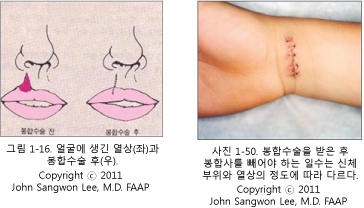Suturing laceration
열상 봉합수술
A wound in which part of the tissue is torn is called a laceration.
Laceration can also occur in the skin layer, skin layer and subcutaneous tissue, mucous membrane layer, uterus, vagina, liver, etc.
Here, we will mainly look into the treatment of laceration sutures on the skin layer or subcutaneous tissue.
If a laceration occurs in the skin layer and/or subcutaneous tissue, depending on the size and depth of the laceration and the part of the body where the laceration occurred, the laceration should be sutured with a suture (surgery thread) or treated with Delmabond, etc.
Either observation treatment is performed without treatment or treatment with a disposable band-aid.
In general, it is better to seek medical attention from a surgeon for incisions around the face, lips, hands, external genitalia, mouth, and eyes.
Ideally, the amount of blood flow is relatively small, and it is ideal to undergo suture surgery within at least 6 hours after the wound is wounded for unclean lacerations infected with bacteria.
Lacerations on body parts that are relatively clean, less likely to have bacterial infections, and less cosmetic problems can be treated with suture surgery up to 24 hours after the laceration wound.
In general, lacerations caused by human or animal bites may not be treated immediately with suture surgery.
If the bite laceration is on the face, seek suture surgery if possible.
After 24 to 72 hours of laceration, the laceration wound can be easily infected with bacteria, and the laceration may fester, and if festered, the wound may be
painful, swollen and red, and there is a warm touch when touched with the hand.

Even though the laceration does not fester and heals normally about 1-2 days after the laceration, it may be red, slightly swollen, and painful to 2~3mm from the edge of the laceration wound.
After the laceration is sutured with a suture, the number of days that the suture can be extracted differs depending on the body part and the function of the body part, and the degree of laceration.
The longer the stitches (sutures) are left for suture surgery, the more pronounced the scars may develop and the more susceptible to infection.
On the contrary, if the seams are removed too early, the edges of the skin split by lacerations may not stick together well.
The skin edge of the laceration wound that was treated with suture surgery may burst if you apply too much force to the laceration wound where the stitches were pulled out after the stitches used in the laceration surgery treatment were pulled out.
Even if the laceration is well sutured with sutures, some scars may develop after receiving surgical treatment.
However, when lacerations are not treated with sutures, they can become more susceptible to bacterial infection, festering, bleeding more severely, and further scarring. If the laceration wound is festering, swollen, or very painful, treat it with topical antibiotic ointments or oral antibiotics according to your doctor’s instructions.
Sometimes, a prophylactic treatment is given to prevent infection of the wound with topical antibiotic ointments or oral antibiotics simultaneously treated with suture surgery.
You should be vaccinated against tetanus with a tetanus vaccine as needed. At the doctor’s discretion, lacerations may be treated with a suture band without suture treatment.
Table 19. The part of the body where laceration occurred, the size and type of the suture, and the appropriate number of days to remove the stitch after the laceration treatment. The size of the suture on the laceration body part (usually used for superficial laceration)
표 19. 열상이 생긴 신체 부위, 봉합사의 크기와 종류, 열상 봉합술 치료 후 실밥을 뺄 수 있는 적절한 일 수.
| 열상 신체 부위 | 봉합사의 크기(표재 열상 봉합술에 주로 씀)
the size and type of the suture, |
흡수성 봉합사(깊은 절상을 봉합술 치료를 할 때 주로 씀
Absorbable suture (usually used for suture treatment with deep cuts) |
절상 봉합술 치료를 한 후 봉합사를 뺄 수 있는 일 수
The number of days the suture can be removed after treatment with laceration repair |
| 두피Scalp | 5~0 또는 4~0 | 4~0 | 5~7일 |
| 얼굴 Face | 6~0 | 5~0 | 3~5일 |
| 안검Eyelid
|
6~0 또는 6~0 | – | 3~5일 |
| 눈썹(미)
Eyebrows (US) |
7~0 또는 5~0ㅍ | 5~0 | 3~5일 |
| 몸통Torso | 5~0 또는 4~0 | 3~0 | 5~7일 |
| 사지 Limbs | 5~0 또는 4~0 | 4~0 | 7일 |
| 관절 표면
Joint surface |
4~0 | – | 10~14일 |
| 손Hands | 5~0 | 5~0 | 7일 |
| 발바닥
Sole 4 |
4~0 또는 3~0 | 4~0 | 7~10일 |
출처 및 참조문헌
-
The Johns Hopkins Hospital, The Harriet Lane Handbook, 18th edition, p.96 and 19th ed
-
Quick Reference to Pediatric Emergencies, Delmer J. Pascoe, M.D.
-
Emergency Pediatrics, A guide to ambulatory care, 5th ed. Roger M. Barkin, Peter Rosen
-
Emergency care and transportation of the sick and injured, American Academy of orthopedic surgeons.
-
Nelson textbook, 15th~19th-21st edition
-
Red book, 27th~29th-31st ed
Copyright ⓒ 2015 John Sangwon Lee, MD., FAAP
“부모도 반의사가 되어야 한다”-내용은 여러분들의 의사로부터 얻은 정보와 진료를 대신할 수 없습니다.
“The information contained in this publication should not be used as a substitute for the medical care and advice of your doctor. There may be variations in treatment that your doctor may recommend based on individual facts and circumstances. “Parental education is the best medicine.”